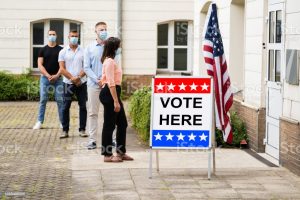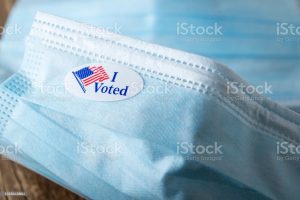14
Jack Sanford
Introduction
Is it worth risking the health of you and those around you to exercise your constitutional right to vote? Health and state government officials have been working closely to develop ways in which people can effectively vote while also maintaining safe protocols to prevent the spread of COVID-19. In order to adequately social distance and curb the spread of COVID-19, various tactics have been implemented throughout the early stages of the voting process. Tactics such as social distancing in line, less voting locations, and a lack of poll workers willing to work during a pandemic creates hazards in the ability for everyone in the United States to secure their right to vote. New research and technology with regard to COVID-19 and voting has created solutions to the difficult task of ensuring that everyone can vote safely. Plexiglass barriers, required masks in line, sanitation, styluses, and protective dividers are all ways in which state officials are attempting to prevent the spread while voting in person before or on Election Day. Following in depth research as to how the virus spreads, states have also enacted new legislation that extended the early or absentee voting period and issued Covid-19 as a valid excuse in order to request a mail in ballot. COVID-19 is a dangerous and deadly disease; the process of hundreds of millions of Americans voting collectively is daunting throughout this time, yet new technologies and research has allowed officials to effectively implement tactics to help curb the spread and save countless lives.
Connection to STS Theory
Issues That Arise Voting During a Pandemic
Throughout the early stages of the COVID-19 pandemic, the Wisconsin primary election proved how dangerous and serious the spread of the virus could be with in person voting. Not enough was known about the virus in April of 2020 in order to implement safe methods of reducing the spread of COVID-19 while also protecting each individual’s right to vote. According to the article “What Democracy Looks Like: Protecting Voting Rights in the US during the COVID-19 Pandemic” written and published by the Human Rights Watch organization Wisconsin officials decided to “reduce the standard 180 polling places” which in turn created longer lines and a larger portion of people attempting to vote at fewer polling precincts. Wisconsin officials also failed to implement effective social distancing and mask laws leaving people susceptible to contracting the virus while voting in person (Human Rights Watch, 2020). This failure to adequately prevent the possibility of contracting the COVID-19 virus while voting in person proved detrimental to the health of Wisconsin citizens. Following the primary, The National Bureau of Economic Research published an essay in which they used extensive scientific research to calculate the exact number of cases that stemmed directly from voting in person. This bureau analyzed phone records in order to trace people’s exact location throughout the day of the primary election. Working closely with Wisconsin health officials, they then established a scientific formula to track the incubation period of the virus forming within people’s immune systems and determined that at least 71 positive cases were

directly contracted the day of the primary (Cotti, Engelhardt, Foster, Nesson, Niekamp, 2020). This research aligns explicitly with the modernization theory of STS. According to the article “Science,
technology, and society” the theory can be defined as “the thought that societies progress from ‘pre-modern’ to ‘modern’ societies” (Science, technology, and society, 2020). We see this as voting procedures immediately adapted to better the population’s health following the Wisconsin primary. States passed legislation that allowed for more time for voters to vote using absentee ballots and implemented laws that require social distancing and masks while waiting in line for in person voting.
Voices of Clemson Undergraduate Students
“When I choose to exercise my Constitutional right to vote on or before November 3rd, I would like to do so knowing I will avoid contracting such a deadly virus”
Ways Federal and State Governments are Changing Voter Laws Due to the Pandemic
As scientists conducted more research to determine how the COVID-19 virus spreads, federal and state governments passed legislation that altered voter laws to adequately protect the health of individuals with the upcoming General Election. For instance, countless state legislatures updated voting requirements to include COVID-19 as an excuse to request an absentee/mail-in ballot form. Previously those excuses were limited to reasons such as the absolute inability to vote in person on Election Day due to a serious health issue or being away from your designated precinct at the time. States like California also passed legislation for automatic mail-in ballots to be distributed to all of their registered voters within their respective states. This was done using the online voter registration system that all government officials have access to ensure that each voter received a ballot. Other states issued a prepaid absentee/mail-in ballot return postage in order to compensate for any monetary issues that might arise for registered voters. This was done using new printing technology in order to guarantee the legitimacy of ballots being returned to limit the chance of voter fraud. Websites such as Ballotpedia.org provided “comprehensive coverage” of how each state was altering their policies using updated technology to ensure that each voter was updated on new ways in which they could safely vote (Ballotpedia, 2020). Companies such as Murcarsel-Powell also released voting toolkits to help voters effectively navigate new voting legislation throughout the COVID-19 pandemic
(Murcarsell-Powell, 2020).
All of this relates to the modernization theory of STS as new technology was used to alter absentee/mail-in ballot forms, ensure that each voter received a mail-in/absentee ballot using the online registration system, and update voters on ways in which their state legislation concerning voting had changed. These strategies allowed the voting aspect of United States society to progress from the ‘pre-modern’ voting to the ‘modern’ way of voting due to the COVID-19 pandemic.
Ways to Safely Vote During COVID-19 Pandemic
There are various ways state and local officials are implementing safe voting practices for those who choose to vote in person in the upcoming General Election. In an article published by CNN Health written by Sandee LaMotte, she highlights safe and effective strategies voters can use to prevent the spread of COVID-19 while voting in person on Election Day. One of those strategies consists of checking the data. Multiple counties within each state have a higher spread of transmission than those surrounding counties. John Hopkins
medical institute provides an interactive and updated status of virus transmission within each county throughout the United States. The solution to voting in a country with a high spread of transmission is re-questing an absentee/mail-in ballot prior to Election Day. Preventative measures can also be taken in terms of wearing a mask while voting and choosing a time of day in which people are unlikely to be packing the polls. However hazardous it may be to vote in person on Election Day, polling precincts are implementing safe voting practices for those that choose to do so. LaMotte

mentions that masks will be required at all times on precinct property, plexiglass barriers will be used to separate poll workers from voters, monitors will be sanitized before and after each voter casts their ballot, protective barriers will be used between booths, and some states will provide styluses of some sort for voters to select their candidate on the monitor (Lamotte, 2020). These preventative measures have been scientifically proven to reduce the spread of the COVID-19 virus through hypothetical situations in which researchers analyzed Election Day scenarios. The extensive research and technology used to implement and inform people of safe voting practices establish the direct relationship between science, technology, and society in our world. People are informed of ways in which science and technology have been used to create safe voting practices, which allows for society to continue with somewhat normalcy amidst a worldwide pandemic.
Conclusion
This unprecedented time of COVID-19 has created complete turmoil within our daily lives and has virtually affected every aspect of our traditional ways. The same is true for the voting process, and as a result of the way COVID-19 spreads, it is a dangerous and challenging process to manage. People must grapple with the idea that by voting in person, they could end up contracting the virus and significantly altering their health and those around them. This is why science and technology is so crucial in dealing with this issue. Federal and state governments have been able to look at scientific data and research and determine the safest ways to ensure that everyone can use their constitutional right to vote. Those same governments and various companies and websites have used advanced technology to spread this information to as many registered voters as possible safely and effectively. These measures are crucial in establishing a secure democracy while also preventing people from getting sick and saving lives in the process. The entirety of these measures have also helped our society advance from one that is ‘pre-modern’ to one that is ‘modern’ in terms of safely
voting during a worldwide pandemic.
References
N.a. (2020). Changes to absentee/mail-in voting procedures in response to the coronavirus (COVID-19) pandemic, 2020. Retrieved October 11, 2020 from https://ballotpedia.org/Changes_to_absentee/mail-in_voting_procedures_in_response_to_the_coronavirus_(COVID-19)_pandemic,_2020.
N.a. (October 6, 2020). Mucarsel-Powell Releases Voting Toolkit To Help Floridians Navigate Voting Amid COVID-19 As Election Day Approaches; Toolkit Includes Info On Where And How To Vote And Tips To Stay Safe Amid Pandemic; Rep. Debbie Mucarsel-Powell (D-FL) News Release. Congressional Documents and Publications. Retrieved October 11, 2020 from https://advance-lexis-com.libproxy.clemson.edu/api/document?collection=news&id=:6111-BT91-JCCP-01YD-00000-00&context=1516831.
N.a. n.d. Science, technology, and society.
N.a. (2020, September 22). What Democracy Looks Like: Protecting Voting Rights In the US During a Pandemic. Retrieved October 11, 2020, from https://www.hrw.org/report/2020/09/22/what-democracy-looks/protecting-voting-rights-us-during-covid-19-pandemic.
Cotti, C. D., Engelhardt, B., Foster, J., Nesson, E. T., & Niekamp, P. S. (2020, May 14). The Relationship between In-Person Voting and COVID-19: Evidence from the Wisconsin Primary. Retrieved October 11, 2020, from https://www.nber.org/papers/w27187.
LaMotte, S. (2020, September 22). Voting safety: How to protect yourself from COVID-19 while casting your ballot. Retrieved October 11, 2020, from https://www.cnn.com/2020/09/01/health/voting-safety-covid-19-2020-election-wellness-trnd/index.html.

